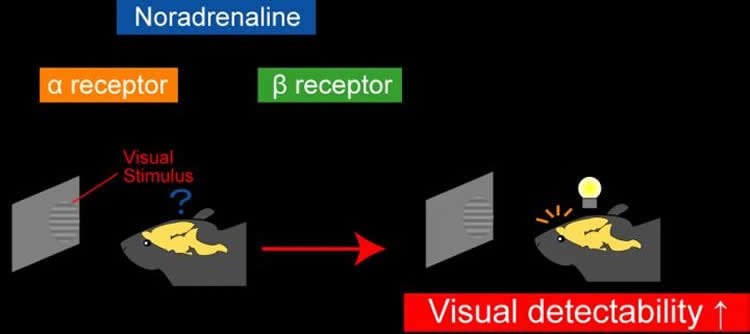Summary: Researchers document the role noradrenaline plays in modulating the primary visual cortex.
Source: Osaka University.
Noradrenaline is a neuromodulator secreted in the brain depending on behavioral context and physiological states of animal, influencing a wide range of physiological functions by modulating brain activity. It may be best known as a hormone to regulate heart rate and blood flow, and many drugs, such as well-known beta blockers, target its effects. It also modulates the visual system.
“Noradrenaline administration modulates the primary visual cortex (V1)”, says Osaka University Associate Professor Satoshi Shimegi. “It changes the spatial sensitivity of this region.”
Understanding how noradrenaline functions in the brain is expected to give new insights on how the brain processes spatial information, which has important implications on patient care and machine learning.
Noradrenaline exerts its effects by binding to adrenergic receptors. Beta blockers target -adrenergic receptors, but there are also exist β-adrenergic receptors, for which there exists alpha blockers. The binding of noradrenaline to its receptors leads to a reduction of spontaneous neural activity in V1, but studies on different animals have been inconclusive about which receptors are primarily responsible for this effect.
In a new set of experiments, the Shimegi lab observed the effects of noradrenaline on the vision of free-moving rats. “We wanted to observe behaving animals, because this is a better representation of nature,” explained Ryo Mizuyama, first author of the study, which can be read in PLOS ONE.
The rats were subjected to one of two different inhibitors of β-adrenergic receptors or one inhibitor of β-adrenergic receptors. Of the three, only the β-adrenergic receptor inhibitor, propranolol hydrochloride, had an effect on vision performance.

“Contrast sensitivity was suppressed”, said Mizuyama, who further added that, “contrast sensitivity defines one’s ability to distinguish objects at different light and dark contrasts.”
Interestingly, however, the effect on contrast sensitivity was found only for a specific range of spatial frequencies.
“The contrast sensitivity at optimal spatial frequencies was suppressed by propranolol hydrochloride,” observed Shimegi. “This result suggests that only neurons sensitive to specific spatial frequencies are affected by the inhibitor. Therefore, noradrenaline could improve vision by targeting a very small subgroup of neurons or neural circuits.”
Source: Saori Obayashi – Osaka University
Image Source: NeuroscienceNews.com image is credited to Osaka University.
Original Research: Full open access research for “Noradrenaline Improves Behavioral Contrast Sensitivity via the β-Adrenergic Receptor” by Ryo Mizuyama, Shogo Soma, Naofumi Suemastu, and Satoshi Shimegi in PLOS ONE. Published online December 16 2016 doi:10.1371/journal.pone.0168455
[cbtabs][cbtab title=”MLA”]Osaka University “Noradrenaline Enhances Vision Through Beta-Adrenergic Receptors.” NeuroscienceNews. NeuroscienceNews, 9 February 2017.
<https://neurosciencenews.com/noradrenaline-vision-6092/>.[/cbtab][cbtab title=”APA”]Osaka University (2017, February 9). Noradrenaline Enhances Vision Through Beta-Adrenergic Receptors. NeuroscienceNew. Retrieved February 9, 2017 from https://neurosciencenews.com/noradrenaline-vision-6092/[/cbtab][cbtab title=”Chicago”]Osaka University “Noradrenaline Enhances Vision Through Beta-Adrenergic Receptors.” https://neurosciencenews.com/noradrenaline-vision-6092/ (accessed February 9, 2017).[/cbtab][/cbtabs]
Abstract
Noradrenaline Improves Behavioral Contrast Sensitivity via the β-Adrenergic Receptor
Noradrenaline (NA) is released from the locus coeruleus in the brainstem to almost the whole brain depending on the physiological state or behavioral context. NA modulates various brain functions including vision, but many questions about the functional role of its effects and mechanisms remain unclear. To explore these matters, we focused on three questions, 1) whether NA improves detectability of a behavior-relevant visual stimulus, 2) which receptor subtypes contribute to the NA effects, and 3) whether the NA effects are specific for visual features such as spatial frequency (SF). We measured contrast sensitivity in rats by a two-alternative forced choice visual detection task and tested the effects of NA receptor blockers in three SF conditions. Propranolol, a β-adrenergic receptor inhibitor, significantly decreased contrast sensitivity, but neither prazosin nor idazoxan, α1- and α2-adrenergic receptor inhibitors, respectively, had an effect. This β blocker effect was observed only at optimal SF. These results indicate that endogenous NA enhances visual detectability depending on stimulus spatial properties via mainly β-adrenergic receptors.
“Noradrenaline Improves Behavioral Contrast Sensitivity via the β-Adrenergic Receptor” by Ryo Mizuyama, Shogo Soma, Naofumi Suemastu, and Satoshi Shimegi in PLOS ONE. Published online December 16 2016 doi:10.1371/journal.pone.0168455






